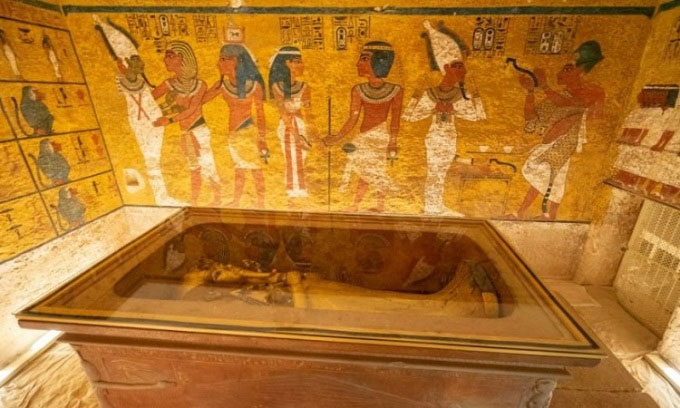What's in the tombs of the pharaohs?
When British archaeologist Howard Carter opened King Tutankhamun's tomb in 1922, he discovered precious treasures including a golden mask, a throne and even a pair of gold sandals. But not every royal tomb in ancient Egypt contained lavish burials. Although the Great Pyramid of Giza and many other Egyptian pyramids are magnificent, the burial items inside are relatively simple compared to those in the tombs of later pharaohs such as Tutankhamun.

Tomb of pharaoh Tutankhamun in the Valley of the Kings.
"Funeral in the largest pyramids can look quite plain compared to Tutankhamun," said Wolfram Grajetzki, a PhD student at University College London, UK, who specializes in ancient Egyptian burial customs. .
The pyramids were used as the tomb of the Egyptian pharaoh from the time of pharaoh Djoser (reigned from 2630 to 2611 BC) to Ahmose I (reigned from 1550 to 1525 BC). Much of the pyramid was plundered decades ago, but a few royal tombs are still relatively intact, according to Grajetzki.
For example, Princess Neferuptah (who lived in 1800 BC) was buried in a pyramid at the Hawara ruins, 100 km south of Cairo. Researchers excavated her burial chamber in 1956 and found pottery, coffins, some gilded ornaments and a series of royal insignia that helped identify the tomb's owner.
King Hor (who lived 1750 BC) was buried with a similar set of clothes, although his remains were not placed in a pyramid. King Hor's body was wrapped in a cold cloth, his internal organs were in a jar. His face was covered with a mask of a mummy.
The tomb of queen Hetepheres, mother of pharaoh Khufu (the builder of the Great Pyramid), contains more elaborate objects. Located in Giza, the tomb has a bed, two chairs decorated in gold, along with pottery and small bronze tools.
The side chamber beneath the unfinished pyramid of pharaoh Sekhemkhet (2611 - 2605 BC) in Saqqara has not been looted by tomb robbers, according to Egyptologist Reg Clark. The king's coffin was empty, but the archaeological team found 21 gold bracelets, a staff and other gold jewelry in a corridor. Although very valuable, the above burial items cannot match the wealth in the tomb of pharaoh Tutankhamun.
Unlike early pharaohs, pharaoh Tutankhamun's tomb is located in the Valley of the Kings, a remote valley near modern-day Luxor that served as a royal cemetery for more than 500 years during the New Kingdom. "This does not mean that pharaoh Khufu was poorer than Tutankhamun. The pyramid of Khufu shows the opposite. Each pharaoh was buried according to the custom of their time," Grajetzki explained.
During the New Kingdom, if possible, the Egyptians often sought to place large amounts of ornaments in the graves. Researchers are not sure why they do this. Although containing less burial material than later tombs, some pyramids have hieroglyphic inscriptions on the walls, recording some curses and rituals, allowing the fusion of two souls separated from the body of the dead. and help them survive in the afterlife.
- Why did the Egyptian pharaohs stop building pyramids?
- The ship brought Egyptian pharaohs to the afterlife
- Valley of Egyptian kings
- Egyptian Pharaoh and deadly curse
- Rare photos inside the Pharaoh's tomb in Egypt
- Valley of Thracian kings
- Decode huge ancient tombs of 2000 year old stone
- Build a house, shudder to hit 42 bizarre ancient tombs
- Ancient tombs of thousands of years carry the form of 'dead boat'
- Six mysterious archaeologists died after opening the ancient Egyptian coffin
- Egypt discovered tombs from ancient Rome
- 6000 year old grave is the first telescope in the world?
 Discovered an ancient centipede fossil 99 million years old
Discovered an ancient centipede fossil 99 million years old Discovered bat-like dinosaurs in China
Discovered bat-like dinosaurs in China Discovered a 200-year-old bronze cannon of the coast
Discovered a 200-year-old bronze cannon of the coast Discover 305 million-year-old spider fossils
Discover 305 million-year-old spider fossils Archaeologist unearths strange 'dragon' in field, expert: 'Report to police as soon as possible'
Archaeologist unearths strange 'dragon' in field, expert: 'Report to police as soon as possible'  'Never Known' Species Found in Qin Shi Huang's Grandmother's Tomb
'Never Known' Species Found in Qin Shi Huang's Grandmother's Tomb  The ancient tombs were all sealed from the inside, how did the last worker escape?
The ancient tombs were all sealed from the inside, how did the last worker escape?  Egyptologist suffers mysterious illness while opening ancient tomb
Egyptologist suffers mysterious illness while opening ancient tomb  Digging a 3,500m high 'water tomb', China found a huge treasure mine, the secret of the Silk Road is revealed!
Digging a 3,500m high 'water tomb', China found a huge treasure mine, the secret of the Silk Road is revealed!  The world's oldest earthquake-proof tomb
The world's oldest earthquake-proof tomb 